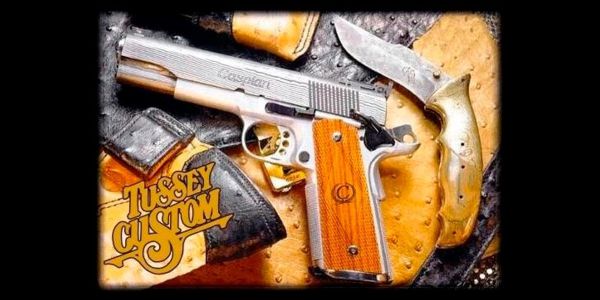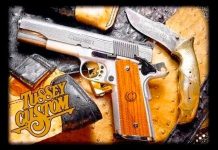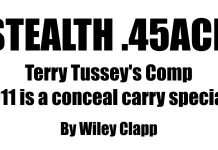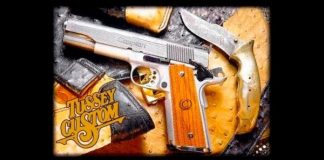The virtues of the Government Model .45 have been endlessly chronicled. But as much as we all love the big gun, it remains just that-a big gun. For all but a handful of pistoleros, full-size 1911s are plainly too large to carry concealed all day, every day. For that reason, dozens of manufacturers have applied themselves to making them smaller
The two guns shown in this story are outstanding examples of the “short and light” 1911 concept. They are among the smallest possible specimens you can find. Both have features never before seen on custom 1911s. The guns were specially crafted at the behest of a Kimber executive on which to display some of his ideas (and some of mine), all flawlessly rendered by pistolsmith Terry Tussey. One of the early competitors in the Southwest Pistol League, Tussey shot the Leatherslap matches at Big Bear with Jeff Cooper. These competitions helped develop his interest in fighting handguns. His interest in custom firearms eventually crystallized into a full-time occupation. Tussey became a respected pistolsmith who is now capable of repairing and modifying all kinds of handguns. But the majority of his time goes into turning 1911s into dream guns. Although Tussey is a technician, he has a strong sense of artistry, and his guns look as good as they shoot.
In this case he started with a single gun and some general guidelines. The pistol was a Kimber Eclipse Ultra II. Tussey’s design mandate was to produce as small a .45 pistol as possible, contoured and equipped for concealed carry. That means first-rate reliability, combat accuracy and ease of handling. In one sense his burden was immeasurably easier because he started with an excellent gun from square one. The Eclipse Ultra II is an all-stainless 1911 with a 3-inch barrel and slide. Butt length is the same as the Colt Officer’s ACP Model. The pistol came from the Kimber plant with an excellent trigger pull and proper reliability, so not much was required in those departments.
CUTTING CORNERS
There are several features on the Eclipse that had to be improved to optimize the pistol for its role as an all-day, every-day hideout auto. Since this type of pistol must be presented from a concealed location, everything that might potentially snag on clothing or equipment had to be eliminated, or at least reduced. As much as we all like prominent square-edged sights that are big enough to be quickly aligned under any lighting conditions, they are prone to catch on things. Both fiber optic and tritium-insert sights have a great deal of merit, as do nontraditional shapes for both front and rear sights.
After much consideration and joint discussions, Tussey started work on the Eclipse, beginning with the sight system. In order to get both front and rear sights completely out of the way, he buried them. Actually, it’s more like he hid them in a ditch. Let me explain:
Tussey removed the existing conventional front and rear sights from the Eclipse slide. The front went into the spare-parts box, while the Kimber-style rear was radically modified. Essentially, Tussey simply ground away everything on the rear sight that projected above the top of the slide. When he was done, the slide top was rounded from front to back. Then Tussey used a ball-end mill to cut a round-bottomed groove from the front of the slide to the rear. He left enough material at the rear end to hand-file it into a shallow “V” shape. The final step was to install a Hi-Viz fiber optic front sight down in the sighting groove. It’s a vivid orange color that you can pick up very easily. Then the slide got a new polish, and the bottom of the sighting groove was done up in matte black.
ENHANCED ACQUISITION
When you raise the little gun to aim, you see a bright orange dot at the front of the sight trough. To align it, simply drop the “pumpkin” into the “V” and hold it on target. From that point on, it’s up to you and your ability to squeeze ’em off and recover from recoil. The system provides a sight picture that is both fast to pick up and easy to use. And the entire system is completely out of sight and out of the way-below the top surface of the slide. Granted, the gun has a highly unusual profile. Sure, it’s nontraditional, but at close ranges, the Tussey Kimber Eclipse is easy to shoot well. The sighting system works beautifully.
There are several other features of the little gun that make it a natural for concealed carry. As most CCW handgunners are painfully aware, the hardest part of a gun to hide is the butt. The less “handle,” the easier it is to tuck away the gun out of sight. As a 1911 specialist, Tussey is aware of this problem and has come up with a fix. He has been selling a number of custom jobs called the Tussey Junior in the past few years. Usually built on a new Caspian frame, the Junior has a butt that runs about three-eighths of an inch shorter than the already-short butt of a Colt Officer’s ACP-style gun. Although Caspian makes frames for Tussey, he can make a butt from scratch on many different makes of 1911 pistols. And that’s what he did with the Kimber Eclipse.
First, Tussey detail-stripped the stainless receiver, then made a careful cut across the bottom of it, leaving it significantly shorter. That was probably the easiest part of the operation. Then he had to make a new mainspring housing and beavertail grip safety, with a new hammer spring strong enough to drop the hammer and whack the primer hard enough to fire. The result is a short butt that seems absolutely tiny in comparison to the original.
Fortunately, Tussey didn’t have to craft special magazines for the pistol. Brownells still lists the Metalform six-shot model for the old Detonics, and it works perfectly.
Tussey did a great deal of custom detailing on the Eclipse, including 30-lpi checkering on the frontstrap. Since the butt is very short, he made a high cut under the triggerguard. This has the effect of giving the shooter a longer frontstrap (I can get almost all of three grasping fingers on the butt).
During my shooting session, I noted that the pistol was relatively easy to control. Another user-friendly touch on the customized Eclipse is its round butt. When you go to a butt this short, the lower-rear corner is well up on the heel of your hand.. If it had the same sharp edge of a conventional 1911-type receiver, it would dig into you-a lot. But Tussey is well aware of this and finished the Eclipse butt with a decent radius that’s easy on your hand. He also did a very nice “carry bevel” treatment on the entire gun and even indulged me with a nice cosmetic touch in the form of a pronounced recurve at the top-front corner of the triggerguard.
Tussey also gave the pistol some handsome (and functional) recessing of the magazine catch on the left side and slide-stop pin on the right.
Finished up with the silver and black treatment and a pair of Tussey’s proprietary slim grips, the Eclipse has been turned into a great little CCW package. Tussey can perform this work on almost all 1911-style pistols. The project started out as an investigation of concealed sight systems, but the short butt treatment seemed a natural thing to add. As the project was nearing completion, we were looking it over one day and the subject of alternative sights came up. We both liked the buried fiber optic front, but we also have a certain fondness for XS Big Dot with a tritium insert in the center. Then we both asked ourselves, Why not try burying one of them?
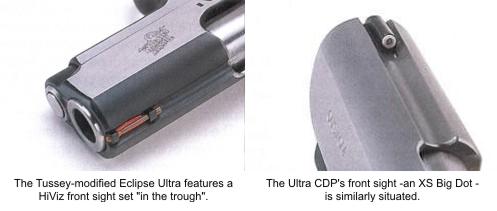
Initially, we fooled with the idea of just building a second slide to go on the Eclipse. But Tussey wanted to try some of the same techniques on a lightweight pistol. Kimber provided another gun, an Ultra CDP II from its Custom Shop. This Model has the same dimensions as the Eclipse, but its alloy receiver gives it a lighter 25-ounce weight than the (initially) 34-ounce Eclipse. Although the Ultra CDP II has a radical “melted” look, with all its edges rounded, the slide is the same three-inch stainless unit used on the Eclipse.
Tussey removed the OEM sights and went to work with the ball end mill. Once again, he had a long, round-bottomed groove running down the top of the slide. The front sight was one of the XS people’s Big Dot tritium units. Since that company’s gunsmiths are so experienced in custom installations of their own sights, Tussey shipped the slide back to them for the front sight to be mounted down in the front end of the groove. In due time it was back, and he finished up the gun.
Instead of a “V” rear, Tussey went with a plain round bottom all the way to the rear. This works quite well because the diameter of the front dot is large enough to almost fill the groove. Aiming is now a function of simply dropping that big marshmallow into the groove and aligning it on the target. It is arguably a little less precise than the fiber optic front of the Eclipse, but it’s extremely fast.
Since the CDP had a bit more custom touches out of the box, Tussey further enhanced it by installing a pair of Smith & Alexander’s new handsomely checkered slim grips. The CDP contrasts handsomely with its Eclipse stablemate. Both show what a skillful pistol smith can do to make a good gun a little better. Kimber is considering some variation of these new features for future model s. (The folks at Kimber would appreciate hearing from G&A readers.)
Tussey can do just about any kind of plain or fancy pistolsmithing. Naturally, he’ll be happy to shorten your butt and bury your sights.
Custom Kimber Compacts
Guns & Ammo
March 2003


